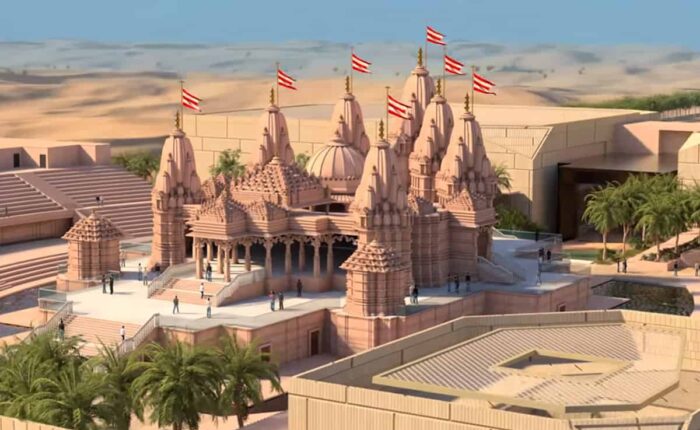Sri Hanumanji in Swaminarayan Sampradaya

Swaminarayan also known as Sahajanand Swami (1781-1830) is the founder of BAPS (Bochasanwasi Sri Akshar Purushottam Swaminarayan Sansthan) which has so far constructed more than 1000 big and small temples in several parts of the world. More than one hundred such Swaminarayan temples are in America alone. The Akshardham temple of New Delhi is also a part of the same Sansthan. The recently inaugurated Abu Dhabi temple is a link in the same chain. The Sansthan is a big builder of temples like ISKCON. The followers of Swaminarayan belong to Swaminarayan Sampradaya.
An article entitled “Sri Swaminarayan Sampradaya Mein Sri Hanumanji Ki Upasana” by Vedanta Shastri Nirgunava Swami is available in the Kalyan Hanuman Ank published by Gita Press Gorakhpur. Sri Nirgunava Swami has been depicted as a religious attendant of Sadguruvarya Swami Sri Narayan Sewa Das Ji who was an eminent saint of this sampradaya.
Swaminarayan Sampradaya believes in only one God. He is the Akshar (Indestructible), Puroshottam (Supreme Personality of Godhead) popularly known as Sri Krishna who is considered an incarnation of Vishnu. In ISKCON also Lord Krishna is the principal deity. However, there is a difference between the belief systems of both. In the article available in the Kalyan Hanuman Ank a shloka from Shikshapatri by Sahajanand Swami has been incorporated which runs as follows.
“Sa Sri Krishnah Param Brahma
Bhagwan Purushottamah
Upasya Ista Devo Nah
Sarva Avirbhava Karanam”
- Shloka 109
This shloka affirms that only Bhagwan Krishna is the supreme personality of God and there is no other for us to pray to. Only Krishna is our deity worthy of Upasana and reverence because He is the cause of all other incarnations. In this way, the Swami Narayan Sampradaya keeps itself aloof from other incarnations and other concepts of Godhood found in the Hindu belief system.
Hanuman becomes an exception:
In the same article, a shloka from Shikshapatri by Sri Swaminarayan Ji has been given which says.
“Bhutad Upadrave Kwapi
Varma Narayan Atmakam
Japyam Cha Hanuman Mantro
Na Japyah Chhudra Daivatah“
- Shloka 85
The shloka says that in case serious problems are created by ghosts (Preta Badha) and other evil spirits, the proper remedy should be the Jap of Narayan Kavach. The second alternative recommended is Hanuman Mantra Jap. Other “Chhudra devta” have been completely rejected.
Swaminarayan Sampradaya has been criticized for its stands relating to general Hindu belief systems. The expression “Chhudra devta” (minor gods) is vague, intriguing and controversial. Branding of other gods as “Chhudra devta” may not be relished by Shaiva, Shakta, Ganpatya and Saur Sampradaya found in India. Most Hindus perform ritualistic Panchayatan Puja and believe in many gods but ultimately in the Trinity and the Parmatma/Parabrahma.
The Swaminarayan temples are living expositions of architecture. They are gorgeous, enormous, expensive and gigantic in scale but can they compete with Kedarnath, Badrinath, Vaishno Devi, Tirupati Balaji and Shirdi Sai Baba temples? Ritualistic traditional Puja by devotees may or may not be allowed in Swaminarayan temples.
However, Hanumanji is the second leading deity in Swaminarayan Sampradaya. The devotion of Hanuman to Ram has been compared to the devotion of a “Patibrata Nari” to her husband by Swaminarayan Sampradaya. This comparison does not look fair. Hanumanji is known for his Dasya Bhava. Meerabai was devoted to Krishna in Pati Bhava. Both can not be declared identical. The devotion of Hanuman remained steadfast in Ram despite subsequent incarnations. Similarly, the devotion of Patibrata Nari remains steadfast to her husband. The comparison seems funny for Hanumanji who is considered to be a Bal Brahmachari.
Hanumanji is very important in Swami Narayan Sampradaya and in all of their temples, Hanuman Mantra Jap is ritualistically performed in the evening. Sri Premanand Swami has composed a prayer for Hanumanji which is sung in the morning and evening aartis in temples of the Sampradaya. The prayer has been transliterated below.
“Jai Kapi Balvanta, Jai Kapi Balvanta
Sur-Nar Muni Jan Vandit, Padaraja Hanumanta
Proudh Pratap Pavansut Tribhuvan Jai Kari
Asur-Ripu-Mada-Ganjan Bhaya-Sankathari
Bhoot Pishacha Vikat Graha Peedat Nahin Jape
Hanumant Hank Sunine Thar Thar Kampe
Raghubir Saahe, Bolagyo Sagar Ati Bhari
Sita Shoadh Leeyara Kapi Lanka Jari
Ramcharan Ratidayak Sharnagat-Trata
Premanand Kahe Hanumant Vanchchit Phaldata.”
I am a Vedic astrologer by profession. I have done Jyotish Acharya from Bhartiya Vidya Bhawan. I am devoted to my Sadguru Shri Sai Nath of Shirdi. I am also interested in spirituality. I love to guide people.